Dirk Campbell
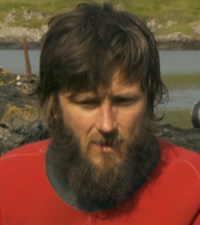
Dirk Campbell is a marine biologist who now dives for scallops.
Dirk Campbell “Traditionally, the West Coast was one of the most productive fishing zones in temperate waters. The ’70s was the heyday of all fishing. It was like the zenith of, like, abundance and industrialisation - they came together and there was just phenomenal fishing catches reported everywhere.”
The demand for fish was insatiable… And the sea appeared to have no limits. But over the next 20 years fish stocks dwindled.
Dirk Campbell “White fish - turbot, monkfish, plaice, cod - that’s the bigger picture, that’s what we’ve lost. And that was in abundance in this sort of heyday. So, very slowly, very insidiously, so that no-one noticed, really - no-one turned round and said, ‘Where have they gone?’ - they just sort of disappeared.”
Fishing the Treshnish Isles
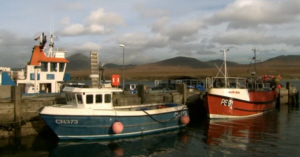
On islands like Islay many fishermen concentrated on catching crabs, lobster and the still plentiful shellfish. The smaller vessels use creels to catch them. It’s sustainable and has a low impact.
This is the Firth of Lorn, near Mull. It’s home to some of the most diverse and fragile reefs in British waters. Dirk and other divers catch the scallops which live here, mainly on the gravelly seabed alongside the reefs. Picking them individually does no damage to other marine life… and it leaves the younger ones behind to grow on.
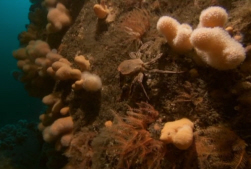
Dirk Campbell “You really need to fish it accurately and sensitively. In the face of abundance, just take enough for your needs.”
Since 2007, this area has been closed to types of fishing more likely to cause damage. The closure is temporary, but Dirk believes he’s already seen the difference it can make.
Dirk Campbell “Very slowly, we are starting to see recovery on a scale that creates excitement.”
For Dirk Campbell, permanently closing off some parts of the coastline is the way forward.
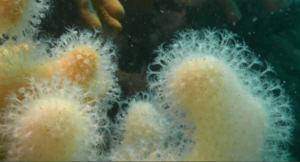
Dirk Campbell “The easiest and most effective way is simply to close off an area and trust in nature. Just leave it, and the rewards will come to you, they’ll leap out the water. I really believe it.”
It’s a bit like leaving the machair to recover between crops, but on a much longer timescale. Perhaps this is the beginning of a new relationship between people and the sea. A healthy sea benefits everyone who fishes… and that includes communities of animals. Huge numbers of gannets - a fifth of the world population - fish off these shores… and, in turn, we can benefit from them. The seabird colonies of the Hebrides are some of the very best.
Alison MacLennan
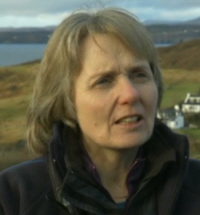
Alison MacLennan “The Hebrides are an absolutely stunning place were seabirds - not just in the UK context, not just in a European context - we’ve got some of the top seabird colonies in the world.”
The Treshnish Isles lie just to the west of Mull… And they are home to everyone’s favourite bird… Puffins… coming back to nest after spending the winter out at sea. But there are dangers on the cliffs above. Ravens will kill puffins. And hooded crows, or hoodies, will mug them for their fish once they are ashore.
But these puffins have some unlikely allies. Every afternoon, a boat arrives, and the puffins know that the ravens and crows are frightened of people. So they wait on the sea until the visitors set foot on the islands. And, as soon as the coast is clear, in they come.
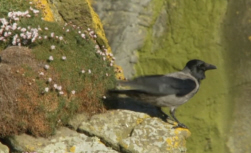
Providing the people show respect, it’s an ideal trade-off. In exchange for getting on with their lives in safety, the puffins give us the views of a lifetime. And everyone loves puffins.
Alison MacLennan “Puffins are such characters. Each one just oozing with sort of character and sort of attitude.”
Puffins mate for life, and they’ve been apart all winter, so now they re-affirm their vows.
Alison MacLennan “They’ve got that really brightly coloured bill and it’s there for a purpose, and there’s a whole series of little head flicking, and beak tapping, and bobbing that’s involved, and, actually, showing off that fantastic bill, and demonstrating that you are the one for your partner.”
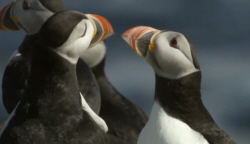
Once they have a chick, both parents will need to gather beakfuls of sprats and sand eels.
Alison MacLennan “These birds will actually let you get really close to them, so you can get a real inside view of what life is like for a puffin. And it’s not easy these days, either. You know, the puffin is one of the species that is relying on sand eels, and sand eels are in a lot of trouble at the moment.”
The problem is the world’s climate is changing, and as the sea warms up there is less food for sand eels, and fewer fish for the puffins. The warming seas have issued another challenge to these islands on the edge. He Hebrides are renowned for storms. And now the effects of climate change are making them even more powerful and unpredictable.
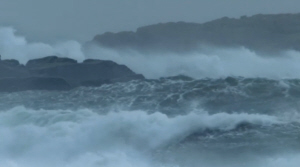
It’s far from easy living here… and many islands struggle to hold on to their people.
The island of Jura. Willie MacDonald is head keeper at one of the estates, and he’s lived here all his life.
Willie MacDonald
Willie MacDonald “Any small island, small population, everything about them is fragile. The economy is very fragile. The population - everything is dictated by the population because you haven’t got enough people to sustain businesses properly. Everything is on the borderline all the time. And I think that’s the way it will always be. Your ferry services, your critical link - that has to the subsidised. So, I mean, everything is fragile. It’s just part of life here.”
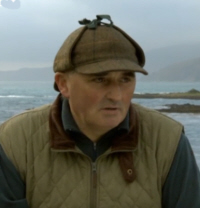
It doesn’t help that Jura is so isolated. The only way to drive on or off the island is from neighbouring Islay. On Islay and Jura there is one animal which brings in more money than any other. On Jura it even outnumbers the people by 30 to one, and it is the mainstay of the island’s economy. The red deer. Jura’s name is appropriate… From the old Norse for ‘Islands of Deer’. How they are managed is critical for both us and them.
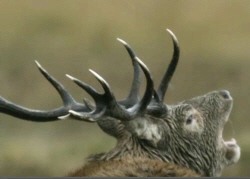
Willie MacDonald “Obviously, the red deer are our dominant wild animal, but, I mean, there’s lots of others as well. We’ve got seven sporting estates, all of them actively involved in deer management, it’s very important to them. If that wasn’t happening, then the deer population on Jura would be… well, it would explode, and that would then bring in a lot of problems with it.”
It’s Willie MacDonald’s job to control the herds by culling to maintain a careful balance between people, the landscape and the deer.
Willie MacDonald “We control the animals - that means that we control the management of the deer herds, farming controls, your birdlife, the environment that these birds and the wildlife lives within. So, man has a huge part to play in that.”
But there’s a fine line between man’s involvement and plain interference. Over on the Uists, there is a non-native animal that has settled in rather comfortably.
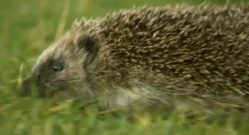
Back in the 1970s, hedgehogs were introduced by a well-meaning gardener to eat slugs. Since then, their population has exploded… and they are eating the eggs of rare waders on the machair, too. And, without natural predators, there are now between 3,000 and 4,000 of these prickly customers running around the islands. But there’s an ongoing project to capture every one… luring them into traps with fish oil… and sending them back to the mainland, where they belong.
When we introduce new animals to these islands, they always cause problems. But there are native animals with roots as deep as ours which had completely vanished… and now we are bringing some back. White-tailed eagles… reintroduced from Norway. The island of Mull is now home to 14 pairs&hellip and plantations of conifers provide ideal places to nest. The eagles were wiped out by hunters - the last bird shot in 1918. But now the white-tailed Eagle is protected by law.
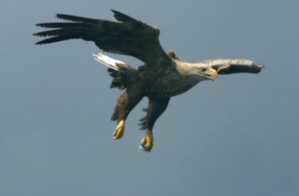
David Sexton
Every new chick is monitored by the Forestry Commission… and David Sexton from the RSPB.
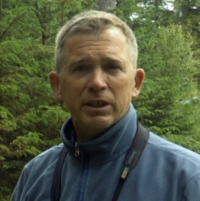
David Sexton “When the chicks are about five or six weeks old, we make a close visit to find out how they are doing, give them a health check. It’s always a tricky operation, we are always a bit worried and concerned, make sure things go well.”
And all under the watchful eyes of the parents.
David Sexton “There’s a bit of flying around and they get a bit worked up to start with, but they soon calm down and we are in and out of here as quickly as possible.”
Even at this young age, it’s best to keep your fingers away from those sharp beaks. Once they’ve settled down, the chicks are ringed to help identify them when they’re older. Reintroducing these eagles to Scotland has been a success. From the first few birds released in the mid-1970s, there are now over 50 pairs breeding in the Hebrides. And, as this year’s chicks prepare to leave, each first flight is a testament to the communities of people who’ve brought them this far.
But bringing white-tailed eagles back has been controversial. They are expert hunters and some farmers fear for their lambs.
David Sexton “They are big predators and we are all getting used to living with a bird again that has been extinct now in Scotland for virtually 100 years. So it does take some getting used to.”
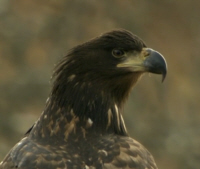
But often they are just scavenging. These two youngsters have found a deer carcass. And, of course, they are commonly called sea eagles for a reason… this is where they search for much of their food. We are getting to know them again, like the islanders who once knew them so well.
Alison MacLennan “There are quite a number of Gaelic names for the white-tailed eagle, but the one that it’s best known for is ‘Iolaire sil na greine’, which means, ‘The eagle with the sun in its eye’. The adult has this beautiful, golden yellow iris to its eye, as if the sun was shining from it.”
And gold is what the eagles are bringing - tourists are flocking here to see them.
Alison MacLennan “They have been a tremendous benefit to the islands. There is a tremendous tourist economy that is just going to see the sea eagles, and it’s bringing somewhere in the region of, for Mull, perhaps about £5 million to the economy each year. They have to say that the white-tailed eagle is something really special for me. They are big long-lived birds with an identity. They are individuals. You can get to know them as individuals and that’s something quite special, I think, in the natural world.”
These islands, with their unique landscapes and spectacular wildlife, have been popular with visitors for a very long time. People have come here for years to take to the water… on paddle steamers, like the Waverley… to visit castles, like Duart… or to cruise alongside dolphins… travel to see the basalt columns of Staffa… journey into the hidden world of Fingal’s Cave. Tourism is set to play a huge role in the future of the people and the wildlife living here. But the key is our relationship with the animals and the home we share with them. If we can farm and fish sensitively… if we can show respect for other lives… and to strike a balance between our needs and theirs… the Hebrides have every chance of remaining so special.
The work that conservationists like Dirk Campbell, Alison MacLennan and David Sexton will play a huge part in securing a positive future for these incredible islands.
External Links
The Treshnish Isles - Wikipedia Page
